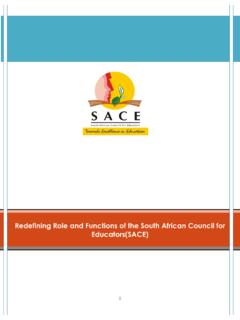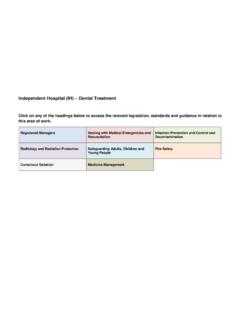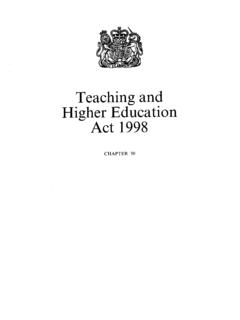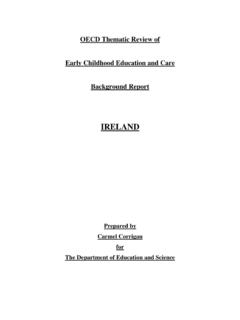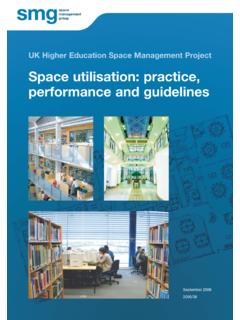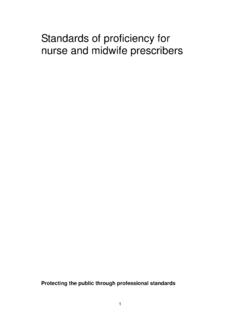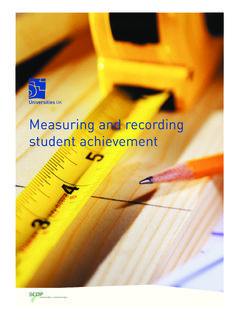Transcription of The Role of the South African Council for Educators (SACE)
1 1 Redefining Role and Functions of the South African Council for Educators (SACE) 2 Redefining the Role and Functions of the South African Council for Educators (SACE) Position Paper March 2011 _____ INTRODUCTION AND BACKGROUND The South African Council for Educators (SACE) has been criticized, to a certain extent, by Educators , teacher unions, and other quarters of the profession for not delivering adequately on its mandate. The interactions held with various teacher unions, Provincial Departments of education , and outreach sessions with Educators , highlighted some of the main concerns with regard to SACE as follows: Non-visibility in provinces in terms of delivering services to the Educators ; Lack of communication with the profession; Not performing its role and is seen as the arm of the Department of education ; Inadequate provisioning of professional development programmes to the Educators ; and Too much emphasis on disciplining Educators These concerns are not new to SACE and continue to be raised by members of the teaching profession on a yearly basis.
2 The fact that the profession is still raising these recurring concerns after thirteen years of SACE s existence may be interpreted differently by various role players and stakeholders. On the one hand, it may mean that as an organization SACE has not reflected and interrogated itself enough to ensure that such concerns are minimized or eradicated completely. On the other hand, different stakeholders, role players and members of the profession interpret SACE s role, mandate, and functions differently and this result in conflicting messages and interpretations of what SACE should or should not be doing. It could also be due to the fact that SACE s strategic goals seem not to be supported by operational and implementation plans that are considerate of the numbers and locations of the registered Educators . The programme implementation strategies 3 seem to be utilizing more financial and human resources but reaching less number of Educators .
3 It is imperative that these issues be interrogated constantly because they contribute largely to the image of SACE and how the profession perceives it While there is criticism from some quarters of the profession, there are still members of the profession who acknowledge the good work that SACE is doing even though it is not reaching as many teachers as the profession would like. The OECD report on reviews of national policies for education in South Africa (2008) regards SACE as one of the most important bodies for the teaching profession in South Africa and it continued to mention that it is well positioned to improve the public image of teaching. The report further commended SACE for developing guidelines for the Professional Development Portfolio which is assisting Educators in taking responsibility for their own professional development and engaging in reflective practice.
4 The Code of Professional Ethics Handbook was also highlighted by the OECD report as one of SACE s key achievements. Against this background, the aim of this paper is to critically analyze SACE s existing role, scope, and functions in the teaching profession. The analysis will be done broadly in terms of SACE s three key mandates so that the strategic planning session participants could have a bigger picture of the organization, its mandate, role, and functions. This will assist in informing the broader SACE vision and the direction that the organization should take and the areas where it should spend its financial resources. Part of the analysis will include research done on some comparison between SACE and the 12 international teaching councils1, and between SACE and the three national professional councils outside the education sector or teaching profession2.
5 This analysis will assist, where necessary, in redefining SACE s role and proposing various ways in which the current role could be tightened up and strengthened for purposes of delivering on its mandate effectively. Furthermore, this 1 Teacher Registration Council of Nigeria, GTC of Wales, GTC of Ireland, GTC of Scotland, GTC of Northern Ireland, GTC of England, Ontario College of Teachers, British Colombia College of Teachers, New Zealand Teaching Council , Queensland College of Teachers, Teacher Registration Board of Tasmania, Teacher Registration Board of South Australia 2 South African Council for Social Service Profession, Engineering Council of South Africa, and HPCSA 4 paper will be circulated internally to the SACE management team and externally to Councilors with the view of receiving feedback and revising it accordingly in preparation for the forthcoming SACE strategic planning session with the stakeholders.
6 UNDERSTANDING WHAT SACE IS SACE is a professional Council that is established in terms of the SACE Act of 2000. For us to understand what SACE is we have to start by looking at its vision, mission, values, legislative mandate, and core functions. Vision According to all the SACE strategic plan documents SACE s vision statement is Towards Excellence in education . In analyzing SACE s vision it is significant to understand that vision provides an organization with an identity and future or long term direction. It also indicates what the organization is committed to. The current SACE vision has been in existence since its inception or for the past 13 years. This also means that for the past 13 years SACE had the vision of moving towards excellence in education . This vision has not been reviewed or updated in terms of the direction that SACE is taking and also in relation to the changes that have been taking place inside and outside of SACE s environment.
7 SACE needs to take stock and reflect on this vision to check if it is still aligned and relevant to what the organization wants to achieve in the next (coming) five to ten years. It is inevitable to talk about redefining SACE s role without updating its mission and vision statements. Furthermore it may also be necessary for the organization to have a re-look at the manner in which its vision statement is worded or crafted. The current SACE vision is, for some reasons, part of the logo. The logo is incomplete without towards excellence in education . In fact the current vision which is embedded in the logo sounds more like a credo statement than a vision statement. Credo is more about the beliefs and philosophy around which the organization revolves and in most cases 5 it (credo) is part of the logo. This is another valid reason why SACE needs a newly worded compelling vision that will guide the entire organization in a particular direction.
8 The implementation of programmes and running of the entire organization will be led by that vision. Mission SACE mission statement states that SACE is a professional Council that aims to enhance the status of the teaching profession, and promote development of Educators and their professional conduct . The mission statement serves largely as the frontline of an organization. It is there to articulate the organization s purpose of existence and what it is trying to achieve. Is the SACE mission statement able to tell the profession and the public what SACE is all about? To a larger extend yes. From this mission one can deduce that SACE's main purpose is to ensure that: The status of the teaching profession is enhanced; It promotes the development of Educators ; and It promotes the professional conduct of teachers Just like the SACE vision, the mission statement has been in existence for 13 years.
9 It needs to be in line with the updated vision and the redefined role of SACE. Legislative Authority The education Labour Relations Act of 1993 established the education Labour Relations Council (ELRC) and section 12 (5) (a) (xiv) of the Act empowers the ELRC to effect: The registration of professional Educators , and the keeping of a register or roll of such Educators for the purpose of regulating qualifications, standards and professional discipline of teachers, and their admission to the education 6 On the 17 October 1994, the Minister of education Prof Bhengu gave notice of his intention to establish a South African Council for Educators (SACE) [Government Gazette No 16037]. SACE was launched in September 1995 and officially recognized by the Minister in January 1997. Initially SACE had two functions: registration and discipline.
10 In November 1997, SACE resolved to extend its responsibilities to include the professional development of Educators . On 2 August 2000, the South African Council for Educators Act was promulgated. Section 5 (a), (b) and (c) of this Act spells out the powers and duties of the Council with regard to registration of Educators , the development of Educators , and promotion of professional ethics. This is supported by section 2 which indicates the Act s three objects as: to provide for the registration of Educators ; to promote the professional development of Educators ; and To set, maintain and protect ethical and professional standards for Educators by means of the functioning of the Council . On 26 April 2007, the Minister of education promulgated the National Policy Framework for Teacher education and Development in South Africa (NPFTED) [Government Gazette No.]
